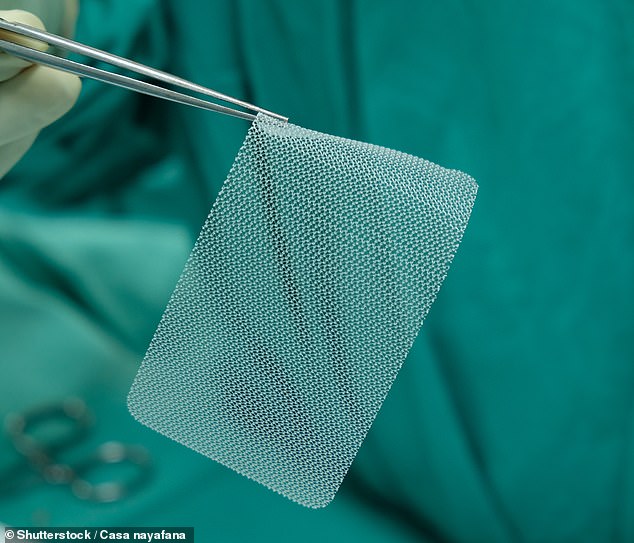Campaigners are demanding an urgent investigation into the safety of surgical mesh used in thousands of NHS breast cancer operations each year.
They fear the material used in breast reconstruction is leaving women with life-changing injuries, chronic pain and relying on a daily diet of painkillers to cope.
There are fears that the mesh is causing harm to some patients, in the same way that vaginal mesh, used in the NHS for years to tackle incontinence, left thousands of people in agony, disabled and suicidal.
One woman told The Mail on Sunday that mesh sewn into her abdomen after cancer surgery left her feeling like someone was “twisting a knife in my stomach”. Another of hers blamed the mesh of her reconstructed breast for an infection that caused her silicone implant to collapse and slide under her armpit. She is now awaiting corrective surgery on the NHS.
The mesh, made of animal tissue or a synthetic material, is implanted into the reconstructed breast to help support the new structure, or into the abdomen to replace muscle and tissue grafted from there to form a new breast.
An estimated 170,000 women were harmed by vaginal mesh
The alarm was raised by campaign group Sling The Mesh, which highlighted the dangers of vaginal mesh, despite doctors initially denying the problem. In 2018, a damning report by Baroness Julia Cumberlege led to the immediate suspension of NHS vaginal mesh operations, after a review heard a catalog of stories of women harmed by the surgery.
In some, the mesh cut into the flesh until it protruded from the vagina. In others, it broke down and passed to other vital organs. The Cumberlege review heard how some women were left needing a wheelchair and unable to work.
An estimated 170,000 women were harmed by vaginal mesh. Kath Sansom, a former journalist who founded Sling The Mesh after suffering health problems due to a vaginal implant, said the group has received an increasing number of complaints from women suffering similar problems with breast mesh.
“It’s like it was 2015, when I was desperately trying to get people to listen to me about vaginal mesh,” she said.
“Many will probably not even realize that they have had mesh implanted, and when they report problems they will be told that doctors have never seen complications in any other woman and to absorb it, as is the case with vaginal mesh.”
Around 57,000 women a year in the UK are diagnosed with breast cancer. About 15,000 undergo a mastectomy, in which the entire breast is removed. About 3,000 a year undergo immediate breast reconstruction, while another 1,500 or so have it done at a later stage.
Surgeons use a variety of techniques to create a new breast.
An increasingly popular method is to use a mesh that works as an “internal bra” to hold new breast tissue (either a silicone implant or fatty tissue taken from the abdomen or buttocks) in place.
Another procedure involves removing muscle and fat from the abdomen to create new, firm breast tissue and then implanting mesh in the stomach area to strengthen it.
A recent study by doctors at Frimley Health NHS Foundation Trust in Surrey, which examined 93 patients who had breast mesh implants fitted, found that just under a third suffered complications in the year following surgery, including failures. of implants and infections.
And in 2021, the U.S. Food and Drug Administration issued a warning that there was an increased risk of complications from implants made from animal tissue. It is usually taken from pigs or cows and all the cells are removed, forming a scaffold-like structure to hold the new breast tissue in place.
The FDA warned that some brands of animal implants were linked to an increased risk of infection. A clinical trial is being carried out at the University of Oxford to compare the safety and effectiveness of mesh versus no mesh in cancer patients.
Liz O’Riordan, a retired breast surgeon and co-author of The Complete Guide To Breast Cancer, said there were often complications with early mesh implants used to strengthen the abdomen after tissue removal. But such surgery is less common in the NHS because it can be traumatic for patients.
However, using mesh to reconstruct breasts is generally much safer, she said. ‘Sometimes patients suffer contractures (where scar tissue around the mesh squeezes the implant, causing pain and a deformed breast), but this technique does not cause the type of long-term complications we see with vaginal mesh. ‘
Jemma Parker, 40, from St Albans in Hertfordshire, says the mesh used to reconstruct her breasts after a double mastectomy ten years ago has left her needing regular doses of the powerful painkiller tramadol.
The mother-of-three, who runs her own beauty business, had her breasts removed at age 30 because she carries the BRCA1 gene which puts her at very high risk of cancer.
“My mother and aunt had breast cancer when they were 30 and I didn’t want my children to see me go through the same thing,” says Jemma. But she is convinced that the porcine mesh implant used is responsible for the silicone implant collapsing and moving into her armpit.
‘It is now pressing on a nerve and causing numbness in my arm. I am in line to have surgery to correct it,” she says.
Studies show that this can happen when the immune system reacts to the mesh, causing the tissue to swell and pushing the implant out of place.
“It’s like a knife twisting inside”

Jane Stoddart, 53, had a double mastectomy in 2011 and, two years later, underwent reconstruction using fat and muscle from her abdomen.
Jane Stoddart, 53, has suffered pain for the past 11 years due, she says, to the effect of the mesh used during her breast cancer surgery.
The mother of three underwent a double mastectomy in 2011 and, two years later, underwent reconstruction using fat and muscle from her abdomen.
“Within a few days I knew there was a problem,” he told The Mail on Sunday.
‘The pain was unbearable, like I was being stabbed and the knife was twisted inside me. That was in April 2013 and I have been in constant agony ever since.”
Jane, from Birmingham, says she was unaware surgeons had used mesh until she needed a hysterectomy, six months after her reconstruction, due to suspected womb cancer.
‘The operation should have lasted a couple of hours but it lasted almost all day.
“Later, the surgeon said my insides were a mess because of the mesh. I had no idea it was even there.
‘I was in too much pain and worried about my recovery to make a complaint. But when I later told the doctors about it, they basically told me it was all in my head.’


